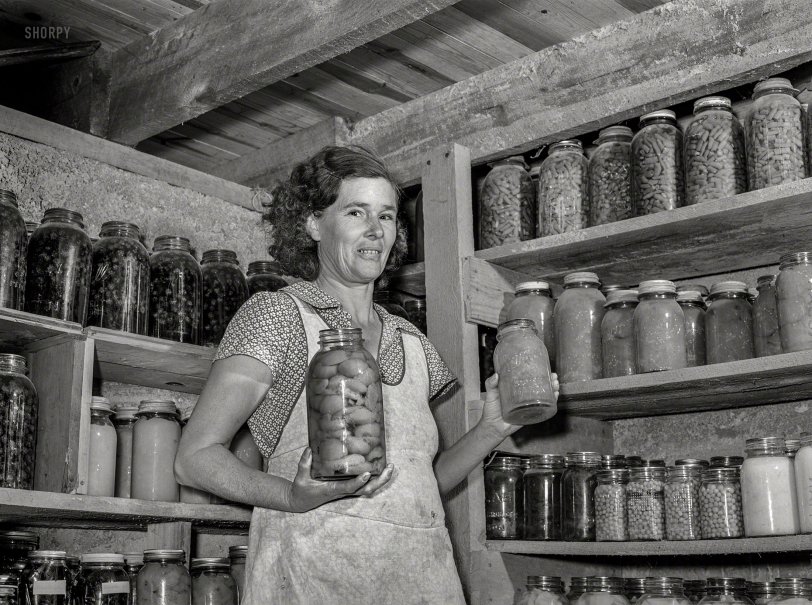


Framed or unframed, desk size to sofa size, printed by us in Arizona and Alabama since 2007. Explore now.
Shorpy is funded by you. Patreon contributors get an ad-free experience.
Learn more.

- Freeze Frame
- Texas Flyer wanted
- Just a Year Too Soon
- WWII -- Replacing men with women at the railroad crossing.
- Yes, Icing
- You kids drive me nuts!
- NOT An Easy Job
- I wonder
- Just add window boxes
- Icing Platform?
- Indiana Harbor Belt abides
- Freezing haze
- Corrections (for those who care)
- C&NW at Nelson
- Fallen Flags
- A dangerous job made worse
- Water Stop
- Passenger trains have right of way over freights?
- Coal
- Never ceases to amaze me.
- Still chuggin' (in model form)
- Great shot
- Westerly Breeze
- For the men, a trapeze
- Tickled
- Sense of loneliness ...
- 2 cents
- Charm City
- What an Outrage
- Brighton Park
Print Emporium
Jars of Plenty: 1939

November 1939. "Mrs. Lawrence Corda, wife of tiff miner, with some of her 800 quarts of food canned under FSA supervision. Washington County, Missouri." Photo by Arthur Rothstein for the Farm Security Administration. View full size.
I remember the day
In 1942 to 1945, my mother and I had as many. Our basement had sheves with quart jars (cans) of chicken, string beans, beets, peas, tomatoes, pickles, peaches, pears, plums and apples. The war years kept us busy, and we would reserve Thursdays for canning. My brothers were at war and my sister was too young, so I was elected to help.
Steel lids
My grandmother continued to use the 'bail' style jars with a glass top and a rubber gasket that then clamped down onto the jar. These went out of favor quite some time ago since there was no way to know if a good seal was made. But grandma never switched over, probably due to the depression-era frugality which they maintained even into the 80's.
Community canneries
My wife is from Appomattox County, Virginia, and until I began visiting that area in 1970 I had never heard of communities having town-owned canneries to which all residents could bring their produce and do their canning with decent equipment. Even in 1970 the cannery was a social occasion in her hometown of 350 people. Sadly, as we go back to visit, we notice that all the canneries are closed and in disrepair these days.
Now we're cooking with ... wood?
Eight hundred quarts of canned food is a very respectable and industrious total, and argues for the Cordas having a large and well-tended garden this year. I would guess there is almost enough to carry them through two winters just from the cellar (depending, of course, on the size of the family--evidence elsewhere suggests the Cordas had four small children at this point).
Besides mining tiff (barium sulfate) ore, Mr. Corda worked a 15-acre subsistence farm, raising oats, corn, and lespedeza for sale as well as keeping a mule for farm work, cattle, hogs, and chickens. I suspect the FSA counted his farm as one of their success stories.
Look at that smile
Until you enlarge, then it looks like she's gritting her teeth and muttering to Mr Rothstein to hurry up and take the blankity-blank picture.
Some can can
However, I do not. Many moons ago I read a true story about a middle-aged woman who picked and canned many, many pints of wild mushrooms. She suffered sudden death and nobody knew why. After her funeral, a traditional repast was served at her home and among the foods served there were some of her delicious canned mushrooms. Within hours, those who ate them were getting symptoms of food poisoning. Some suspected that the wild mushrooms were poisonous, but it was soon discovered that was not the case but they had botulism which can come from improper sterilization and sealing of canning jars. Although botulism kills only about 5 to 10 percent of it's its victims, to me it was like playing Russian roulette. I decided I would never do any canning, even though my mom did can tons of garden produce every summer and it never made anyone ill. I just wouldn't take that chance. I have however eaten lots of wild mushrooms but that can be a gamble too and you've got to know your stuff.
























On Shorpy:
Today’s Top 5